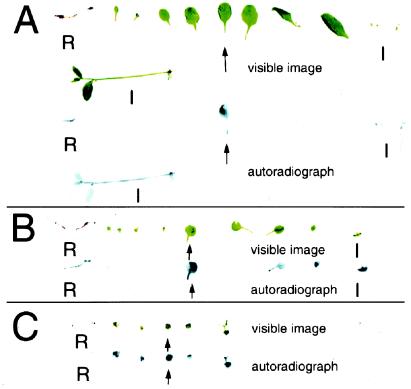Figure 5.
Results of movement of 14C-sucrose in wild-type and suc2 mutant plants. Shown are dissected parts and the corresponding autoradiographs of plants fed 14C-sucrose in drops applied to a crimped rosette leaf (arrow). The organs are laid out in the following order: roots (R), cotyledons and rosette leaves in developmental order, and inflorescences (I), both primary and axillary. All plants are siblings grown under identical conditions. (A) In this wild-type plant, most of the labeled sucrose moved to the roots and axillary and primary inflorescences. No label is found in rosette leaves other than the fed one. (B) In this smaller wild-type plant, included to rule out differences between mutant and wild type being based solely on size, again most of the labeled sucrose moved to roots and inflorescences, with a small amount moving to younger rosette leaves (possibly still sinks). (C) In this suc2–1 mutant plant, most of the labeled sugar moved to other rosette leaves, both younger and older than the fed leaf. No label moved longer distances to the primary sink organs like roots or inflorescences.

